Spotted Joe Pye Weed, also known as Eutrochium maculatum, is a native perennial wildflower found in wetland areas across America. It is a member of the Asteraceae family and is valued for its beautiful flowerheads and its importance to wildlife and conservation efforts.
The name “Joe Pye Weed” is believed to have originated from a Native American healer named Joe Pye, who used the plant for medicinal purposes. This plant is also sometimes referred to as “joe-pye” or “joe-pye weed” and has various synonyms, including Eupatorium maculatum and Eupatoriadelphus maculatus.
Spotted Joe Pye Weed is characterized by its large, fuzzy leaves that grow in opposite pairs on erect, branching stems. The plant can reach a height of up to 8 feet and prefers partial sunlight and moist soils. It is often found in wetland areas such as swamps, marshes, and along riverbanks.
The flowerheads of Spotted Joe Pye Weed are composed of many small, pink to purple disc flowers and are arranged in flat-topped clusters. These flowerheads can reach a diameter of 6 to 12 inches and attract a variety of pollinators, including bees, butterflies, and hummingbirds, with their sweet scent.
One interesting fact about Spotted Joe Pye Weed is that it gets its name from the brown spots that can appear on its stems and leaves. These spots are actually glands that give off a pleasant vanilla-like scent when crushed.
Spotted Joe Pye Weed has great value in landscaping, as it can add height and color to gardens with its impressive stature and attractive flowers. It is also an important plant for wetland restoration and conservation efforts, as it helps improve soil quality and provides habitat for wildlife.
In terms of growth, Spotted Joe Pye Weed is a clump-forming plant that spreads through underground rhizomes. It can form large colonies in favorable conditions and is often seen blooming in late summer to early fall. The plant’s blooming period can vary depending on the region, with some subspecies blooming as early as July.
In summary, Spotted Joe Pye Weed is a beautiful and beneficial native wildflower that thrives in wetland areas across America. Its attractive flowers and importance to wildlife make it a popular choice for both natural and landscaped areas. If you’re looking to add height and color to your garden, or want to support wetland conservation efforts, consider planting Spotted Joe Pye Weed!
Eutrochium maculatum – spotted Joe-Pye weed
Eutrochium maculatum, commonly known as spotted Joe-Pye weed, is a native plant species in North America. It belongs to the family Asteraceae and is found in wetland areas, including wet meadows, marshes, and stream banks.
The plant can reach a height of up to 7 feet and has large, elliptic leaves that are arranged opposite each other on the stem. The leaves are dark green and can have a powdery or fuzzy texture. The stem is purplish in color and can be covered with glands or spines.
Spotted Joe-Pye weed blooms from mid-summer to early fall, producing clusters of pink or purplish flowers. The flowerheads are composed of many small, tubular florets and are arranged in flat-topped clusters. The flowers are highly attractive to butterflies and other pollinators.
The plant’s fruit is a small, dry seed with a tuft of hairs that aid in wind dispersal. It is an important food source for various birds and small mammals.
Spotted Joe-Pye weed is a valuable addition to wetland restoration projects and landscaping schemes. It is often used in rain gardens and wet meadow plantings. The plant is tolerant of a wide range of soil types and can thrive in both full sunlight and partial shade.
Notes:
- Eutrochium maculatum is sometimes referred to as Eupatorium maculatum.
- The plant is native to eastern and central North America.
- Other common names for the plant include purple Joe-Pye weed and sweet Joe-Pye weed.
- Some forms of Eutrochium maculatum, such as ‘Gateway’ and ‘Little Joe’, have been selected for their more compact growth habit and improved flower characteristics.
- While the plant is not considered invasive, it can spread and form large colonies if not properly managed.
- Native plant nurseries and landscaping companies often carry Eutrochium maculatum and related species.
- For more information on Eutrochium maculatum, visit the USDA Plants Database or contact your local extension office.
Sponsors: Eutrochium maculatum seeds – Landscaping America, Eutrochium novae-angliae seeds – Moore’s Nurseries, Eutrochium fulgida seeds – Minnesota Wetlands
Photos and comments:
- Spotted Joe-Pye weed in bloom
- Close-up of the flowerhead
- Spotted Joe-Pye weed leaves
- Spotted Joe-Pye weed in a wetland area
- Love the fragrance of the flowers!
Key information:
- Scientific name: Eutrochium maculatum
- Common names: Spotted Joe-Pye weed, spotted eupatorium
- Family: Asteraceae
- Plant status: Native
- Height: Up to 7 feet
- Leaf arrangement: Opposite
- Flower color: Pink, purplish
- Blooming season: Mid-summer to early fall
- Habitat: Wet meadows, marshes, stream banks
New England distribution
Spotted Joe Pye Weed is a native plant species that can be found in New England. It is distributed throughout the region, but is least common in the northern parts of New England. It is considered a species of least concern in terms of conservation status.
The plant forms tall clumps and can reach heights of up to 6 feet. It has large, ovate leaves and its stems are hairy and sometimes purple-spotted. The flowers are arranged in dense, dome-shaped heads and are usually pink or pale purple in color. The flowers are showy and fragrant, attracting butterflies and bees.
Spotted Joe Pye Weed prefers moist soil and can often be found in wet meadows, swampy areas, and along the edges of streams and ponds. It can also be found in open spaces such as prairies and roadsides. It is a common sight in parks and natural areas throughout New England.
There are several varieties of Spotted Joe Pye Weed, including Eupatorium maculatum, Eupatorium purpureum, and Eupatorium fistulosum. These varieties differ in their characteristics such as flower color, height, and leaf shape.
Spotted Joe Pye Weed is a popular plant for garden and landscape design. It is often used in meadow gardens and as a backdrop for other plants. It is also commonly found in native plant nurseries and is a favorite among gardeners who love wildflowers.
| Genus | Eupatorium |
|---|---|
| Family | Asteraceae (Aster family) |
| Length | Up to 6 feet |
| Flower color | Pink or pale purple |
| Characteristics | Large ovate leaves, hairy stems, showy flowers |
| Habitat | Moist soil, wet meadows, swampy areas, stream and pond edges, open spaces |
| Distribution | New England |
| Conservation status | Least concern |
In addition to its beauty and fragrance, Spotted Joe Pye Weed provides important services to the ecosystem. Its flowers provide nectar for pollinators, and its seeds are a food source for birds. It also plays a role in habitat restoration and can be used in projects aimed at restoring wetland areas.
Overall, Spotted Joe Pye Weed is a beautiful and valuable plant that adds color and diversity to the New England landscape.
North America distribution
The spotted Joe Pye weed (Eutrochium maculatum) is a native plant species found in North America. It is natural to wetland areas, meadows, and woodland edges. Its distribution covers the majority of North America, from Minnesota to Florida and from the east coast to the Midwest.
The plant can be found in various habitats, including wetlands, woods, and parkland. It thrives in moist to wet loam soil and can often be found growing along the edges of rivers and streams. It is sometimes seen in landscaped gardens and native plantings as well.
The plant is known for its tall stems, which can reach heights of up to 7 feet or more. The stems are often fuzzy and have a purplish hue. The plant’s foliage consists of large, fuzzy leaves, which are sometimes purple-spotted. Its flowers appear in mid-summer and are arranged in dense heads, with each head containing numerous small purple flowers. The flowers have a pleasant scent and attract bees, butterflies, and moths.
The plant also produces fruit in the form of flat seeds. The seeds are contained in a structure called an ovary, which is located at the base of the flower. The seeds can sometimes be dispersed by wind or water, allowing the plant to spread and colonize new areas.
In North America, there are several subspecies of the spotted Joe Pye weed, including Eutrochium maculatum subsp. maculatum and Eutrochium maculatum subsp. foliosum. Each subspecies has its own unique distribution and characteristics.
The spotted Joe Pye weed is highly valued for its ornamental qualities, attracting gardeners and nature enthusiasts alike. Its tall stems and large, vibrant flowers make it a standout in any garden or landscape setting. Additionally, its status as a native plant adds ecological value, as it supports and attracts various wildlife species.
For more information on the distribution and characteristics of the spotted Joe Pye weed, you can visit the following resources:
- The Flora of North America
- The Bradley Method of Dichotomous Key
- Photos and descriptions of the plant on various botanical websites
Whether you encounter the spotted Joe Pye weed in its natural habitat or in a cultivated garden, its beauty and ecological value are sure to leave a lasting impression.
Facts
The Spotted Joe Pye Weed, scientifically known as Eupatorium maculatum, is a non-native plant species in North America. It is a member of the Flora family and is sometimes referred to as the purple-spotted Joe Pye Weed. The plant is native to wetlands, moist thickets, and other low-lying areas.
The Spotted Joe Pye Weed is characterized by its tall growth, reaching up to 6 feet in height. The plant has large, showy flowerheads that are made up of many tiny flowers. These flowerheads are surrounded by purplish bracts, adding to the plant’s beauty. The flowers bloom in late summer and early fall, attracting bees, butterflies, and other pollinators with their sweet scent.
One interesting fact about the Spotted Joe Pye Weed is that its stems and leaves are covered in a fuzzy texture, giving them a velvety appearance. Another interesting characteristic is that some of the plant’s varieties have leaves with purple spots, hence the name “spotted” Joe Pye Weed.
The Spotted Joe Pye Weed is often planted in gardens for its aesthetic qualities and its ability to attract wildlife. It is also used in wetland restoration projects, as it can help improve the quality of the soil and provide habitat for native flora and fauna.
It is important to note that the Spotted Joe Pye Weed can be invasive in some areas, crowding out native plants and disrupting natural ecosystems. In these cases, proper maintenance and control measures should be taken to prevent its spread.
The plant’s scientific name, Eupatorium maculatum, is derived from the Greek words “eu” meaning “well” and “pateo” meaning “to tread.” This refers to the belief that the plant’s roots were used to treat ailments related to the feet.
In conclusion, the Spotted Joe Pye Weed is a beautiful and versatile plant that is native to wetlands and various low-lying areas in North America. It makes for stunning garden plantings, attracts pollinators, and plays an important role in wetland restoration projects. However, caution should be exercised to prevent its invasive spread and protect native plant species.




